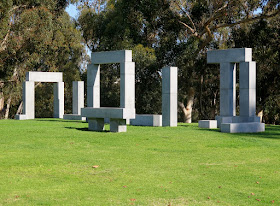Of the blogs I read, only a search on the Armchair Hiker San Diego finds Yuha in the Search Bar. Not a very popular destination! The Yuha Desert is located on BLM land south of I-8.
The map shows 7 sites worth a visit:
1. Overlook
2. Yuha Well
3. Yuha Desert
4. Yuha Geoglyph
5. Fossil Shell Beds
6. Crucifixion Thorn
7. Historic de Anza Campsite
My weekly BLM NewsBytes (Issue 886) contained this article:
<quote>
New Audio Tour for the Juan Bautista de Anza Historic Trail
Want to learn more about the Juan Bautista de Anza National Historic Trail? A new audio tour and map for the trail through Imperial County are available on our website! The 1,200-mile Juan Bautista de Anza National Historic Trail commemorates, protects, marks, and interprets the route traveled by Anza and the colonists during the years 1775 and 1776 from Sonora, Mexico (New Spain), to settle Alta California and establish a mission and presidio at today's San Francisco, California. (BLM Facebook)New Audio Tour for the Juan Bautista de Anza Historic Trail
<end quote>
Follow the BLM Facebook link to listen/download the audio and/or download the map.
I have been to the intaglios and the Anza viewpoint in the past, but not the other points of interest. With the release of the commentary, now I have a perfect excuse for a day trip!
and started the Juan Bautista de Anza National Historic Trail on BLM Trail 274.
This is also the main east/west trail through the desert.
The kiosk has good information to review, although its map is slightly different then the previous two.
The 7 points of interest are the same numbers as above, which I will use in the remainder of this blog.
This kiosk is also the starting point of the Audio Tour. The audio describes the Yuha Desert (#3) including excerpts from both the journals of Padre Font and Juan Bautista de Anza.
.
The Yuha Desert is second to Death Valley as the most brutal in the US.
The first of the three stops on the audio tour is the Anza Overlook (#1), via BLM Trail 308 off BLM Trail 274.
.
.
.
Returning to Trail 274 the Yuha Geoglyphs (#4) are the next stop. The narration here is performed by a native Kumeyaay elder. It’s really hard to see the glyphs from ground level. A drone would help. (The intaglios in Blyth are much better preserved.)
.
.
This picture is from DesertUSA.com, showing the complete glyph from above
 |
| from Desert USA . com |
.
.
At this point I could continue on Trail 346 to the Fossil Shell Beds (#5), but as the wind was becoming a factor I returned to Trail 274. Thus the option of reaching the fossils later or exiting to the east, or returning the way I came.
The radio said the wind was 25 mph with gusts to 35 and would increase to 50+. Yikes – I exited to the east while the trails were still mostly visible. Although Signal Mountain is now barely visible in the dust cloud.
Camancho’s Place between El Centro and Seely has been a favorite for a ‘dive’ Mexican joint. Lunch with a Cerveza Mexicali, a new beer from Tecate.
.
.
The wind did indeed get stronger and I totally forgot about the Crucifixion Thorn (#6) as I headed home on I-8 instead of my plan of using CA 98.
Along with the Shell Beds something for next time!
Some notes:
Good cell signal, except in the remote canyons
Trails altho mostly hard pack are often off-kilter, rutted and at time technical. High clearance 4x4 is required
Download the audio and map from the BLM Facebook page
It’s BLM land – dog friendly and dispersed camping
The only known glyph of a man on horseback is found in the Piedras Grandes, perhaps of this expedition
Certainly a fun and educational off-road adventure.
















































